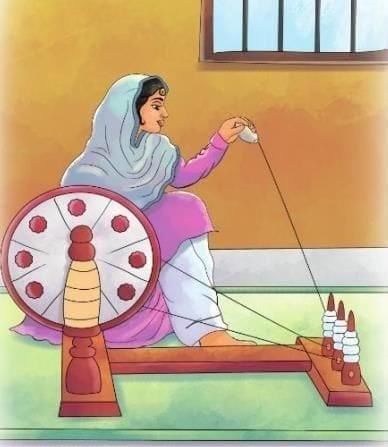Summary: Indian Weavers | English Class 4 ICSE PDF Download
| Table of contents |

|
| Introduction |

|
| Key Points of the Poem |

|
| Summary |

|
| Message |

|
Introduction
"Indian Weavers" is a beautiful poem written by Sarojini Naidu, an Indian poet known as the "Nightingale of India." The poem describes the life and work of weavers who create special clothes for important moments in life. It shows how their work changes with the time of day and connects to events like birth, marriage, and death. Using simple words and vivid colors, the poem celebrates the skill of weavers and their role in these special occasions.

Key Points of the Poem
- The poem is about weavers who are skilled at making beautiful clothes.
- It explains how weavers work at different times of the day for special occasions.
- The poem connects their work to important life events like the birth of a baby, a royal wedding, and a funeral.
- It shows the colors and feelings linked to each event through the clothes they weave.
Summary
Stanza 1
Weavers, weaving at break of day,
Why do you weave a garment so gay?
Blue as the wing of a halcyon wild,
We weave the robes of a new-born child.
This part describes weavers working early in the morning when the day begins. Someone asks them why they are making a cheerful and colorful cloth. The weavers explain that they are creating soft, blue clothes for a newborn baby, comparing the color to the bright blue wing of a special bird called a halcyon.
Stanza 2
Weavers, weaving at fall of night,
Why do you weave a garment so bright?
Like the plumes of a peacock, purple and green,
We weave the marriage-veils of a queen.
Here, the weavers are shown working late at night when the day ends. They are asked why they are making a bright and shiny cloth. They reply that they are weaving special veils for a queen’s wedding, using colors like the purple and green feathers of a peacock, making it look grand and beautiful.
Stanza 3
Weavers, weaving solemn and still,
What do you weave in the moonlight chill?
White as a feather and white as a cloud,
We weave a dead man's funeral shroud.
In this part, the weavers work quietly and seriously under the cold moonlight at night. Someone asks what they are making. They say they are weaving a plain white cloth for a dead person’s funeral, describing it as white as a feather or a cloud, showing a sad and calm mood.
Message
The poem teaches us about the amazing skills of weavers and how their work is important for celebrating life’s happy moments and showing respect during sad times. It shows how they use different colors and times to match the meaning of each event.
New Words with Meanings
- Halcyon: A type of bird with bright blue feathers, known in stories as a beautiful bird.
- Robes: Special clothes, in this case, made for a baby to wear.
- Plumes: Long and colorful feathers, like those on a peacock.
- Veil: A light cloth worn over the face, often used in weddings.
- Solemn: A serious and quiet way of doing something, showing respect.
- Shroud: A white cloth used to cover a dead body during a funeral.
FAQs on Summary: Indian Weavers - English Class 4 ICSE
| 1. What is the central theme of the poem "Indian Weavers"? |  |
| 2. How does the poem reflect the cultural significance of weaving in India? |  |
| 3. What emotions are expressed through the imagery used in the poem? |  |
| 4. How does the structure of the poem enhance its message? |  |
| 5. In what ways does the poem serve as a commentary on the human experience? |  |














